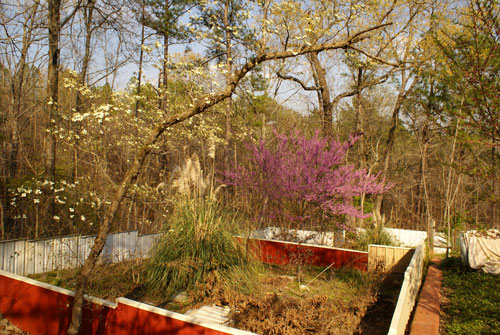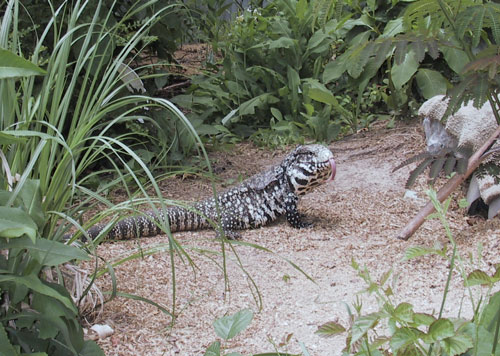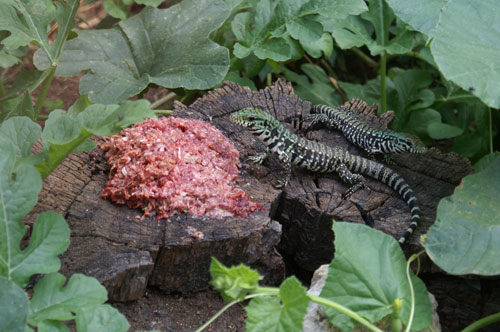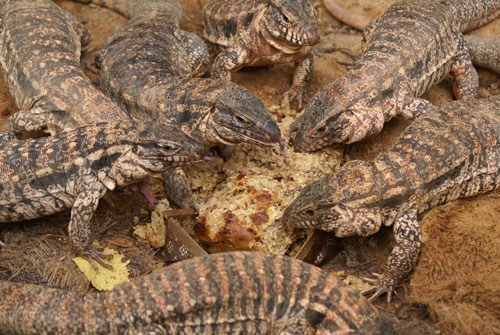Supplement to the June 2008 REPTILES magazine article "Totally Tegus."
Lizardkeepers can keep tegus both outdoors and indoors.
Outdoor Housing
I keep tegus outdoors, and I often simply fence them in with corrugated, galvanized metal. I bury this fence 2 feet deep in the ground, and it stands 3 feet tall above ground. So far, no tegus have escaped under or over these fences. Make the enclosure’s perimeter at least 4 feet by 8 feet.

Bert Langerwerf
Some of the author’s tegu enclosures include pampas grass, a plant native to South America. It’s the grass clump with the white tufts.
Corrugated plastic tubes, such as those used for drainage, can be used to simulate burrows. Tegus hide in these tubes or make a room at the end. If you have the space, tubes can lead to hide boxes somewhere cooler, so the lizards have more temperature choices. You also could create a small sliding door to close the “burrow.” This way you can clean the enclosure without disturbing the tegus.

Bert Langerwerf
This Argentine black and white tegu is in one of the author’s 1,000-square-foot outdoor enclosures.
Tegu hide boxes should contain a slightly moist substrate, such as leaves or hay, to provide humidity. Wild tegus spend about 80 percent of their time in moist underground burrows, so captive tegus that lack these moist hide boxes encounter shedding problems.
Hide boxes also should have an inspection door, so you can check on the tegus or check for eggs. I use chimney blocks for my hides. These pieces are exactly the right size (1 foot by 1.5 feet by 2 feet), and they don’t rot in the ground. The blocks have round openings at the top, and I cover them with large water bowls filled with dirt. I surround the rest of the chimney blocks with dirt until 8 inches of dirt covers them. By lifting the water bowl tops, I can see into the hides. In the winter I place a big heap of leaves over these hiding places.

Bert Langerwerf
These baby Argentine black and white tegus (Tupinambis merianae) are eating ground chicken. The author grinds bones into the meat.
Indoor Housing
It’s best if indoor enclosures have a perimeter of 4 feet by 8 feet like outdoor enclosures. Tegus free to roam around the house don’t need an enclosure this big; however, tegus loose in the house may encounter low humidity levels, which result in shedding problems. In principle, indoor enclosures do not need walls higher than 3 feet tall, but local regulations might actually state otherwise. A friend in Florida told me he was fined because the walls of his tegu enclosure were less than 4 feet tall.
A moist hide box is a must indoors. It prevents a tegu from having shedding problems. Some lizardkeepers soak their tegus every now and then, but this is not enough. A daily soaking is not the same as a moist hide. Five minutes after soaking, the tegus are dry again.

Bert Langerwerf
The author occasionally feeds his tegus bread, which is what these yearling red tegus (Tupinambis rufescens) are eating.
Ultraviolet light is very important indoors. Along with shedding problems, nutritional secondary hyperparathyroidism is a common problem in lizards, including tegus. I keep my tegus outside so I don’t have to worry about indoor lighting. However, tegus kept indoors must have UVB lighting, so buy lights developed for lizards and made by well-known manufacturers. Familiarize yourself with the bulb’s effective UVB range, and always follow the manufacturer’s guidelines for bulb replacement.
Heat lamps often make tegu enclosures too warm, so watch the temperatures. The basking spot should be between 90 and 100 degrees Fahrenheit. The rest of the enclosure should be in the 80s. Always arrange heat lamps and UV light bulbs so tegus cannot touch them. Strong wire mesh between the lamps and tegus is best.
Feeding
Tegus accept a wide range of food. Although wild tegus are mainly vegetarian, captive tegus tend to prefer animal matter. They prefer birds because it is easier for them to find baby birds than mammals in their native habitat. My tegus eat mainly chickens, which I cut up for them. Sweet fruits, such as grapes, bananas and cantaloupe, are another staple food. Occasionally my tegus even eat bread.
Baby tegus eat insects, pinky rodents and ground meat (but be sure to add calcium). Occasionally I give them a boiled egg or canned cat food. Do not use cat food as a staple food; only cats should eat it that way.
If you keep tegus indoors, it is best to give them food early in the morning, so tegus do not associate your hands with food and accidentally bite you. Even very tame tegus can make a mistake.
Want to read the full story? Pick up the June 2008 issue of REPTILES today, or subscribe to get 12 months of articles just like this.


